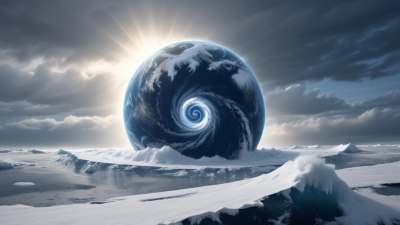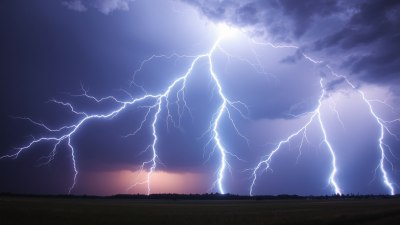What If Earth’s Poles Flipped and How Weather Would Spiral
Explore the consequences of Earth's magnetic pole flip and its impact on global weather patterns.

This image was created with the assistance of Freepik
The concept of Earth's magnetic poles flipping, also known as geomagnetic reversal, is both fascinating and alarming. It raises numerous questions about the potential impact on our planet's weather and climate systems. Understanding how such a phenomenon could occur and what it would mean for life on Earth is crucial to mitigating any negative effects that could arise. In this article, we will explore the implications of a pole flip on weather patterns, ecosystems, and human activities.
Understanding Pole Reversal
Earth's magnetic field is generated by the movement of molten iron within its outer core. This magnetic field protects the planet from solar radiation and cosmic rays. Over geological timescales, the magnetic poles have flipped many times, with the last reversal, known as the Brunhes-Matuyama reversal, occurring approximately 780,000 years ago. A magnetic reversal does not happen overnight; it is a prolonged process that can take thousands of years.
How a Pole Flip Occurs
The exact mechanism behind geomagnetic reversals is still a topic of scientific research. Some theories suggest that changes in the convective patterns of molten iron in the outer core lead to instabilities in the magnetic field. As the field weakens and fluctuates, poles can shift and eventually flip. Satellite data indicates that the magnetic field has been decreasing in strength, prompting scientists to question whether we might be due for another transition soon.
Impact on Weather Patterns
The most immediate effect of a magnetic pole reversal is not on temperatures or precipitation, but rather on the magnetic field itself. However, as the magnetic field weakens, it becomes less effective at shielding the Earth from high-energy solar winds and cosmic rays. This could lead to significant consequences for weather patterns around the globe. For instance, increased solar radiation could elevate temperatures in certain areas, leading to dramatic changes in climate.
Shifts in Atmospheric Circulation
The distribution of temperature and pressure across the globe is influenced by Earth's magnetic field. A weakening field could disrupt existing weather patterns and lead to unpredictable shifts in atmospheric circulation. This could result in altered trade winds, jet streams, and ocean currents, all of which play essential roles in distributing heat and moisture across the planet.
Extreme Weather Events
With altered atmospheric circulation, we could witness an increase in extreme weather events. Persistent droughts, intense storms, and even hurricanes might become more frequent in certain regions. For instance, areas that currently experience mild weather might start to endure harsh winters or scorching summers. These changes could devastate agriculture and disrupt food systems worldwide.
Regional Effects on Ecosystems
As weather patterns shift, so too will the ecosystems that depend on them. Many species are finely tuned to their environments, and even slight changes in temperature and precipitation can threaten their survival. Migratory patterns of birds and fish could be disrupted, leading to consequences for entire food chains. In extreme cases, local extinctions could occur as species struggle to adapt to their new conditions.
Impact on Human Life
Human society has evolved within a climate framework shaped by thousands of years of stability. Changes brought about by a pole flip could challenge our infrastructure and way of life. For instance, altered rainfall patterns could impact water supply and agriculture, leading to food shortages and increased conflict over resources. Furthermore, a rise in extreme weather may lead to the increased frequency of natural disasters, prompting displacement and necessitated migration.
Historical Analogues
While direct evidence of weather shifts linked to geomagnetic reversals is scarce, paleoclimate records suggest enduring patterns during these transitions. For example, during the last major pole reversal, global average temperatures did not significantly shift. However, regional climates did experience upheavals, leading to extinction events for certain species. Thus, understanding these past events helps us predict potential scenarios and prepare for possible outcomes.
Mitigating Risks
While a magnetic pole reversal cannot be prevented, knowledge about its potential impacts can aid in mitigating risks. Advancements in climate modeling and satellite technology empower scientists to better monitor changes in the Earth's magnetic field and predict consequent shifts in weather patterns. Additionally, preparedness measures, such as strengthening infrastructure to withstand extreme weather events, can help society adapt to the potential changes that lie ahead.
Global Collaboration and Awareness
Addressing the potential consequences of a pole flip involves global collaboration. Scientists, policymakers, and communities must work together to understand the risks and develop adaptive strategies. Enhancing public awareness and education about geological processes and climate change can foster resilience and encourage collective action. It is imperative that we engage in conversations about how to safeguard our planet and its inhabitants during periods of change.
The Takeaway
In conclusion, the possibility of Earth's magnetic poles flipping raises significant concerns about our planet's weather and climate systems. While the reversal itself may not cause immediate catastrophic changes, the secondary effects could reshape life as we know it. Understanding the processes behind geomagnetic reversals not only broadens our scientific knowledge but equips us with the tools to prepare for the unpredictable consequences of such a phenomenon. The journey ahead requires vigilance, research, and most importantly, cooperation among all people to navigate and mitigate the risks associated with this geological reality.











